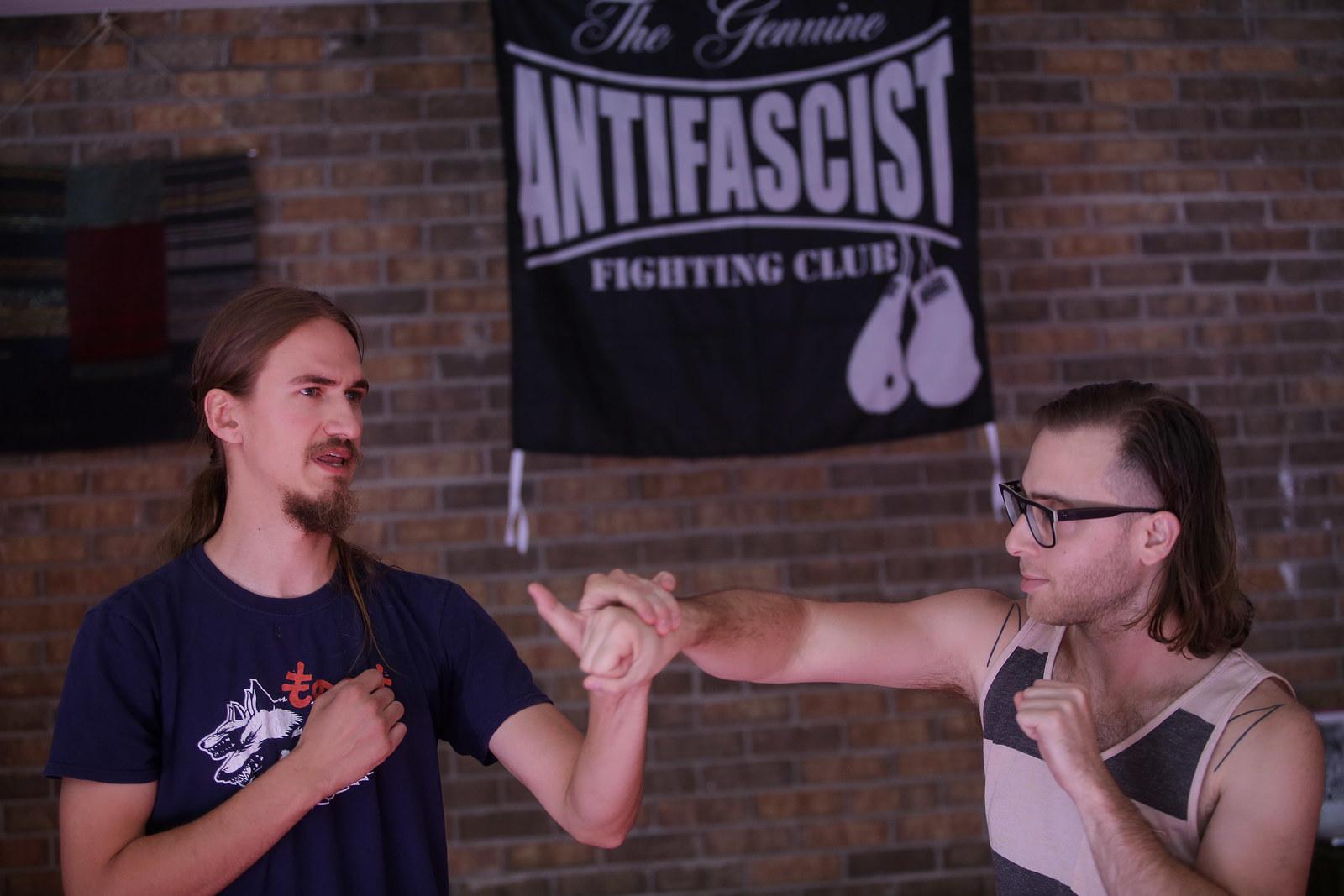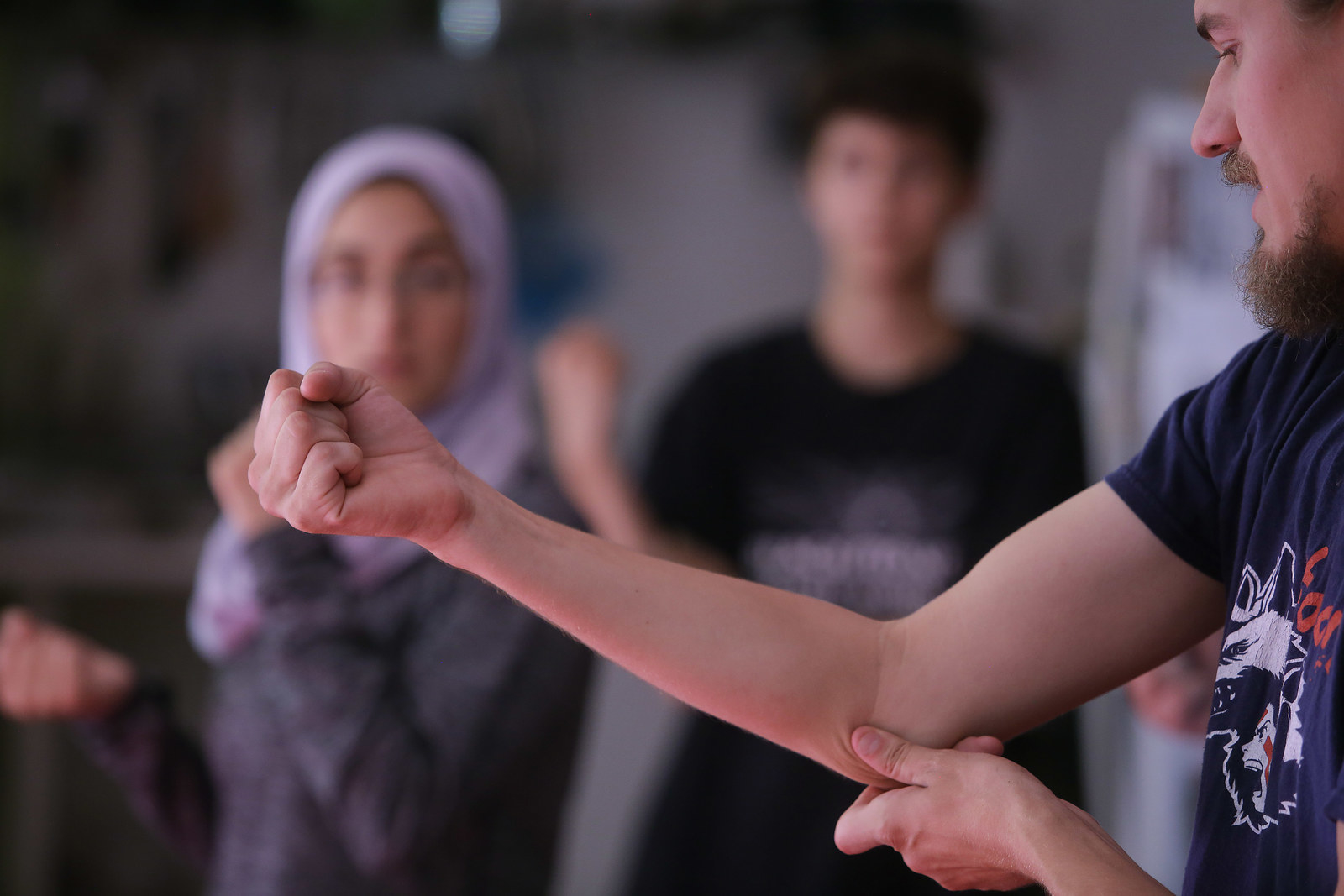The anti-fascists are wearing their sweatpants today. Tennis shoes are a must. They’ve been told to wear something breathable — no masks, no bandanas, no armor. Almost nobody wears black (almost nobody).
Gym members drift in through the door of the Breakaway Social Center in the Little Village neighborhood on Chicago’s West Side. The two-story corner building was once home to a $10-a-haircut barbershop, but now the walls are lined with posters bearing anarchist symbols and advertising a recent lecture on militant suffragettes.
The couches are pushed back to the walls, next to shelves stacked with political journals. On the floor, warm-ups begin. The class splits into small groups to learn a couple new moves — thrust kicks, palm heel strikes.
Lean in, turn hips for momentum, and follow through once, striking the jaw — that’s how to punch a neo-Nazi.
One of the gym’s organizers, who goes by Meyer Lanski (a play on the Jewish gangster Meyer Lansky), instructs participants to stand in line. Lanski, 32, holds out a kick shield and braces himself to receive their blows. Even some of the new participants are landing their kicks. Within the hour, the women and men start sparring, learning self-defense tactics they can use in their private lives, or at protests.

The Haymaker Collective is one of many anti-fascist groups that began offering self-defense courses in the wake of Donald Trump’s election and the political upheaval that has followed. Some groups train their members for unforeseen attacks, while other antifa organize more militant trainings to equip people with arms or prepare them for confrontations at protests.
Antifa are most often portrayed as a violent, left-leaning counterpart to the far right, seen in protests marching in all-black and bashing in windows. In April, antifa at a free speech rally in Berkeley set fires and engaged in street brawls with alt-right groups. At a protest in the same city this August, they pushed a Trump supporter to the ground and beat him until a reporter intervened. Antifa critics claim that the movement’s more violent factions do unjustifiable harm and dampen the message of peaceful protesters. Some say they play into the hands of the alt-right, who hope to gather sympathy by portraying themselves as the victims of the militant left.
“At the end of the day, stronger people are harder to kill.”
But anti-fascists maintain that defense and street confrontations are necessary to subdue the far right. In Charlottesville, antifa stepped in to protect clergy members from an advancing crowd of neo-Nazis. And after Charlottesville, offshoots of the Unite the Right rally flailed in the face of mass resistance movements in cities like Boston and San Francisco.
Members of Haymaker and other more militant anti-fascist factions consider the far right a threat, and one they must physically prepare to defend themselves from. As reports of hate speech and violence have dominated this past year, antifa say their membership is increasing not just with militants, but also with people who have been targets of racism and bigotry. The methods they choose to employ are as diverse as their ranks — with some taking up arms and others turning to hand-to-hand combat. Beyond just self-defense, the increasing intensity on both sides could mean bigger brawls than anything seen at Charlottesville, with neither side prepared to step down.
“At the end of the day, stronger people are harder to kill,” Lanski said.

In workshops, trainers point out the different strategies for dealing with protesters or the police. “Police are more systematic, whereas fascists are unpredictable,” Lanski said. He and other gym members analyze news and amateur footage of protests online, and shape their trainings accordingly. In addition to one-on-one combat, they practice group fights as well.
As much as Haymaker attempts to prepare for protests that could turn violent, Lanski understands the limits to what the gym can teach. He knows there’s no way to prevent what happened in August in Charlottesville, where Heather Heyer was killed when a car barreled through a crowd of anti-racist counterprotesters. “I don’t think any of us are naive to think that self-defense could have changed what happened,” he said.
To protect those battling it out in the streets, many antifa groups train members in street medicine. Those medics monitor the crowds, handing out water and sunscreen and acting as first responders if police bring out tear gas or a confrontation gets heated. The medics typically come from nursing or emergency medicine backgrounds, but many are laypeople trained by other street medics before them.
But many antifa who spoke to BuzzFeed News said medical training alone won’t protect them during confrontations. During the street fights that broke out in Berkeley between antifa and white supremacists earlier this year, Sean Hines realized that his side wasn’t ready for that kind of confrontation with the right. “To be quite frank, they kicked our ass in a lot of instances … it was kind of an eye-opener that we really needed to start training,” Hines said.
“The more people that are armed, the more that we have the ability to fight police terrorism or fight fascist terrorism.”
He created a fight club in Santa Rosa, California, to teach combat training to like-minded antifa. “Antifa had strength in numbers, but when it came to symmetrical combat, we would usually lose,” he said.
Hines also founded an anarchist and socialist gun club, integrating guns into antifa self-defense to arm working-class people and create a “left-wing militia.” He’s not alone — several antifa groups are taking advantage of lax gun laws in their states and arming their members.
“The more people that are armed, the more that we have the ability to fight police terrorism or fight fascist terrorism,” said Joseph Jordan, an anarchist who participates in Seattle antifa groups. “When the fuckers see that we are willing to shoot back, they back the fuck off.”
On the East Coast, John — who asked to be identified only by his first name, as he has been arrested for possessing illegal ammunition in the past — said he feels the left has not moved quickly enough to acquire guns. “People say, ‘When the revolution happens, we’ll find the weapons.’ But weapons don’t just materialize out of nowhere,” he said. “We should take advantage of the fact that our country lets people bear arms.”
John aspires to bring the left onto equal footing with the far right, which he noticed has more effectively integrated weapons into its fighting strategy. “They basically take military doctrine and bastardize it,” he said.
In April, Phoenix’s anti-racist, gunslinging John Brown Gun Club posted a video of its members at a range, clad in black and masked in red bandanas, firing at Pepe the frog targets — and missing. The video circulated among the online right, and not in the way that the John Brown Club intended. Instead of intimidating white supremacists with a demonstration of force, the video elicited jokes about the group members’ lack of gun safety knowledge.
“The biggest thing, I think, is for the left to really figure itself out. In its current state, it’s not prepared whatsoever,” John said. “You’re inviting the right wing to attack you.” But the more people the left can arm, and arm effectively, the less the right can laugh in their faces, he argues.
John only encourages the use of guns for defending oneself or anyone else getting attacked. But he sees them as a necessary tool within a larger set of antifa strategies — a controversial stance when massacres like the one in Las Vegas have led to calls for stricter gun control laws.
Guns, John said, can aid in combating white supremacist and far-right terrorism, which he has noticed often involves a single actor carrying out shootings en masse; such was the case with Dylann Roof in Charleston and Robert Lewis Dear in Colorado Springs. “If the right wants to come and massacre us, then we’ll massacre them,” he said.
At gun ranges, anarchists John and Jordan take aim alongside conservative Second Amendment defenders. Often, they take newcomers out to the range to get a gun in their hand for the first time.
Besides the arms trainings, John and Jordan also host martial arts and physical combat trainings. But in the face of Nazis heading down the streets with AR-15s, they don’t feel hand-to-hand defense offers enough protection.
“If there was a legitimate war, martial arts wouldn’t be that useful,” John said.

“After Trump got elected, for the first time ever I went out and bought pepper spray,” said one Haymaker organizer who goes by the pseudonym Naila. A Midwest native, Naila is Muslim, wears a hijab, and has spent much of her life as one of her small community’s visible minorities. Her local mosque has been vandalized. People driving down the street have stopped to yell slurs at her. So this June, she started carrying the pepper spray.
“But having a can of pepper spray is very different than knowing what to do when you are physically capable,” she said. Haymaker’s trainings have made her more aware of her surroundings and her own body’s natural reactions.
Naila said that more Muslim women like her feel an urgent need for self-defense and have started showing up for trainings.
Naila said that more Muslim women like her feel an urgent need for self-defense and have started showing up for trainings. The gym strives to reach individuals who could be targeted by hate crimes across various backgrounds, particularly Muslims and Jews.
And they aren’t the only ones who see themselves at risk. Seattle anarchist Jordan, who is black, has noticed that many of those who have shown new interest in arming themselves, some who have never shot a gun before at all, are people of color or queer. They feel that their life is “in danger in a very direct way right now,” Jordan said.
Haymaker’s Lanski, who is Jewish, has seen anti-Semitic slurs cover synagogues in his city. He has been a victim himself. A few years ago at an anti-fascist protest, Lanski was attacked by white supremacists and ended up with his teeth knocked out. He’s scared to live in the United States now more than ever — but the gym has helped him feel more confident about his ability to defend himself.

As a black man, Jordan said that sense of urgency is constant. “I’ve always seen the degree to which a potential escalation to the point of legal force is necessary, and it’s what this fucking country is founded on.”
Antifa aren't the first leftists to promote self-defense against fascism. In founding Haymaker, Lanski said he was inspired by Pacifico Di Consiglio, a Jewish-Italian teenager who started an anti-fascist boxing gym in the Jewish ghetto in 1938 in the face of Mussolini’s anti-Semitic policies.
Jordan finds inspiration in Rob Williams, the first US civil rights leader to encourage armed resistance to racial violence. He formed and trained the Black Guard, who came to the aid of black residents in North Carolina when law enforcement would not, making him one of many leaders to advocate the long-debated idea of fighting violence with violence.
Typically, though, men have dominated these movements — a problem contemporary groups still face but are working to combat.
“We’re trying to build a space for people who may not be accepted by heteronormative macho gym culture,” Lanski said.
For him, Haymaker is as much about building strength as it is about building community. “People feel very scared, and one of the effects of fear is isolation,” he said. “This is one of the ways we want to break away.” ●
Outside Your Bubble is a BuzzFeed News effort to bring you a diversity of thought and opinion from around the internet. If you don't see your viewpoint represented, contact the curator at bubble@buzzfeed.com. Click here for more on Outside Your Bubble.
